Sandia polymer electrolyte membrane brings goal of a high temperature PEM fuel cell closer

SANDIA RESEARCHERS Cy Fujimoto, left, and Chris Cornelius hold a test micro fuel cell with the Sandia membrane. Next to Fujimoto is a micro fuel test station. (Photo by Randy Montoya) <br>
A new type of polymer electrolyte membrane (PEM) is being developed by researchers at the Department of Energy’s Sandia National Laboratories to help bring the goal of a micro fuel cell closer to realization using diverse fuels like glucose, methanol, and hydrogen.
This Sandia Polymer Electrolyte Alternative (SPEA) could help fulfill the need for new, uninterrupted autonomous power sources for sensors, communications, microelectronics, healthcare applications, and transportation.
The membrane research is one part of a three-year internally funded Bio-Micro Fuel Cell Grand Challenge led by Chris Apblett, Sandia principal investigator, and Kent Schubert, Sandia project manager.
Recently the membrane research team headed by Sandia researcher Chris Cornelius demonstrated that the new SPEA could operate as high as 140 degrees C and produce a peak power of 1.1 watts per square centimeter at 2 amps per square centimeter at 80 degrees C. Under identical operating conditions, the SPEA material can deliver higher power outputs with methanol and hydrogen than Nafion. Nafion is recognized as the state-of-art PEM material for fuel cells.
Because the SPEA material can operate at elevated temperatures, it enables several key benefits that Nafion cannot provide. These advances include smaller fuel cell stacks because of better heat rejection, enhanced water management, and significant resistance to carbon monoxide poisoning. These performance properties suggest that the SPEA material may be a potential alternative to Nafion.
Cornelius notes that a higher temperature PEM material is one of the goals of the DOE’s Hydrogen, Fuel Cells, and Infrastructure Technologies Program. http://www.eere.energy.gov/hydrogenandfuelcells/. One milestone is to develop by 2005 polymer electrolyte membranes for automotive applications that operate at 120 degrees C for 2,000 hours with low membrane interfacial resistance.
Of the new SPEA material that Cornelius and Sandia researcher Cy Fujimoto developed, Cornelius says, “Validation of this material as a Nafion alternative would be a significant achievement, an accomplishment we strongly desire.”
A polymer electrolyte membrane is a critical component of a working fuel cell. Its function is to conduct protons efficiently and possess low fuel crossover properties. It must also be robust enough to be assembled into a fuel cell stack and have long life.
In developing the SPEA material, the team looked at the success and limitations of other PEM alternatives in order to develop a set of characteristics for their model material.
“At the beginning of this project we were considering several polymer families for a PEM alternative, including a family of polyphenylenes,” Cornelius says. “When the physical properties of one of the polyphenylenes being considered as a polymer electrolyte was improved and integrated into a working fuel cell, we happily discovered that it works extremely well compared to Nafion.”
Cornelius says that the SPEA material he and Fujimoto are developing “may be an enabling material that could have an impact on the fuel cell community and help Sandia become recognized as a fuel cell research organization.”
“We have already completed initial material validation studies of our SPEA with the help of our battery group and Los Alamos National Laboratory,” he says.
The next steps, Cornelius says, are to reduce the internal resistance in the fuel cell membrane electrode assembly, optimize catalyst and ionomer composition, improve the properties of the SPEA material, conduct life cycle testing in a fuel cell environment, and assess the potential value for large-scale commercialization of the polymer electrolyte.
Understanding the material’s capabilities and limitations are necessary steps in order to potentially improve the physical properties of SPEA material.
“We see this SPEA material as having the potential of being integrated into fuel cells ranging from microwatts to kilowatts,” he says. “Such a broad power range means that this Sandia Polymer Electrolyte Alternative could be used in a fuel cell to power everything from sensors, cell phones, laptops, and automobiles.”
Sandia is a multiprogram laboratory operated by Sandia Corporation, a Lockheed Martin company, for the U.S. Department of Energy’s National Nuclear Security Administration. With main facilities in Albuquerque, N.M., and Livermore, Calif., Sandia has major R&D responsibilities in national security, energy and environmental technologies, and economic competitiveness.
Sandia media contact: Chris Burroughs, coburro@sandia.gov, 505-844-0948.
Sandia technical contact: Chris Cornelius, cjcorne@sandia.gov, 505-844-6192.
Sandia National Laboratories’ World Wide Web home page is located at http://www.sandia.gov. Sandia news releases, news tips, science photo gallery, and periodicals can be found at the News Center button.
Media Contact
All latest news from the category: Power and Electrical Engineering
This topic covers issues related to energy generation, conversion, transportation and consumption and how the industry is addressing the challenge of energy efficiency in general.
innovations-report provides in-depth and informative reports and articles on subjects ranging from wind energy, fuel cell technology, solar energy, geothermal energy, petroleum, gas, nuclear engineering, alternative energy and energy efficiency to fusion, hydrogen and superconductor technologies.
Newest articles

NASA: Mystery of life’s handedness deepens
The mystery of why life uses molecules with specific orientations has deepened with a NASA-funded discovery that RNA — a key molecule thought to have potentially held the instructions for…

What are the effects of historic lithium mining on water quality?
Study reveals low levels of common contaminants but high levels of other elements in waters associated with an abandoned lithium mine. Lithium ore and mining waste from a historic lithium…

Quantum-inspired design boosts efficiency of heat-to-electricity conversion
Rice engineers take unconventional route to improving thermophotovoltaic systems. Researchers at Rice University have found a new way to improve a key element of thermophotovoltaic (TPV) systems, which convert heat…



